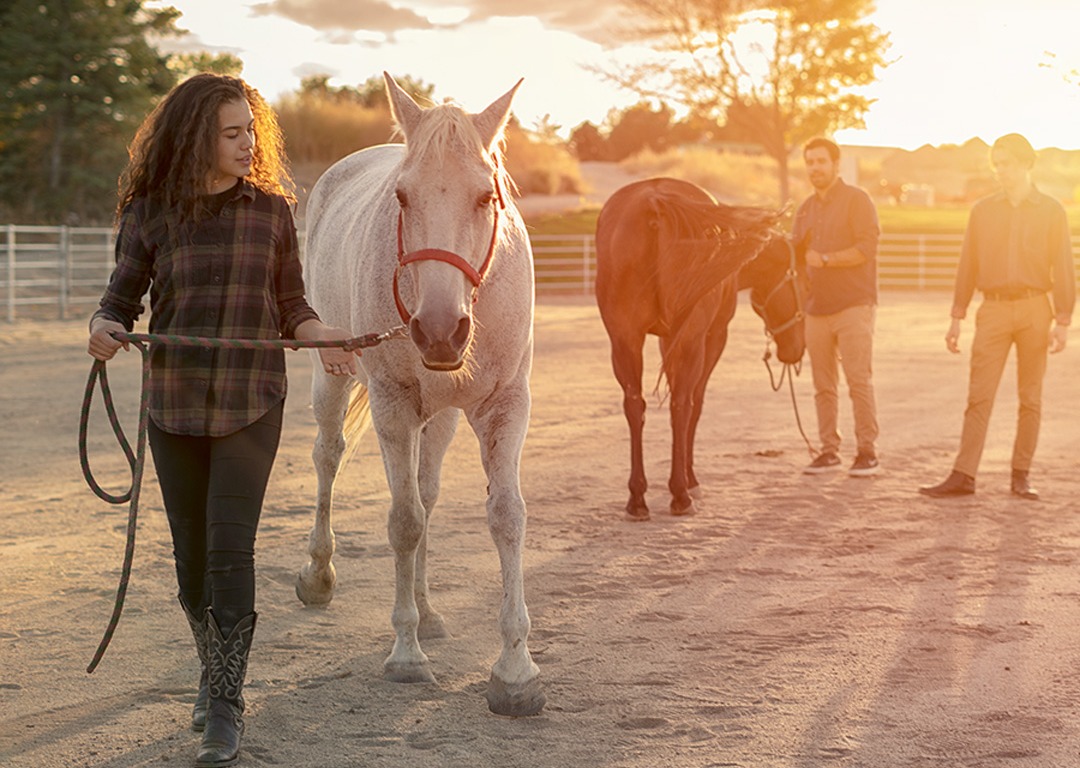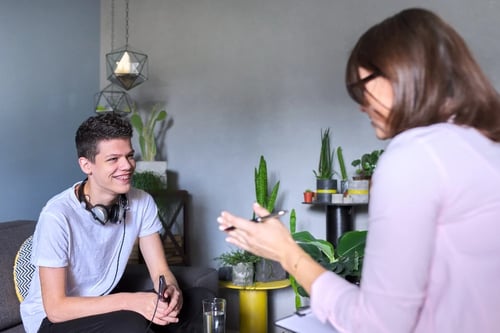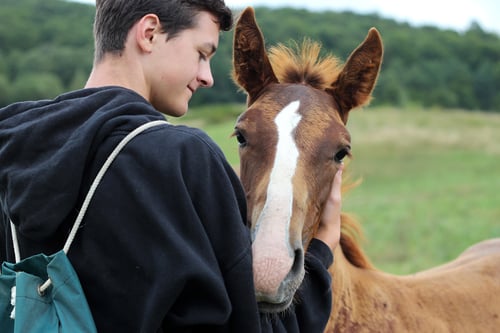Equine Therapy for Teen Anxiety
The EAGALA Model
Many parents struggle to help their teenagers manage feelings of anxiety. Symptoms like constant worry, muscle tension, fatigue, irritability, and difficulty sleeping and concentrating can take a major toll on a teen’s mental health and day-to-day functioning. When anxiety becomes overwhelming or unmanageable, professional treatment is often needed. One unique therapeutic approach that has shown great promise in treating anxiety in teens is equine therapy.

Table Of Content
- Ground-Based Activities Used in EAGALA Equine Therapy
- Why EAGALA Therapy Reduces Anxiety in Teens
- What to Look for in an EAGALA Equine Therapy Program
- Methods Teens Use to Hide Self-Harm
- Well-Intentioned Deception
Equine-assisted therapy uses interactions with horses to help promote emotional growth and learning. Leading the way in equine therapy approaches is the Equine Assisted Growth and Learning Association (EAGALA), which focuses specifically on ground-based interactions with horses. This means no horseback riding is involved. Instead, licensed mental health professionals team up with equine (horse) specialists to create thoughtful ground-based activities with horses that address each client’s treatment goals.
The EAGALA model has proven highly effective in helping teens cope with anxiety for several reasons. First, horses are large and powerful, which demands a teen’s attention and focus in their presence. Hypervigilance and heightened reactivity, common symptoms of anxiety, are therefore channeled positively as skills needed to participate in therapy. Horses also act as mirrors, reflecting a teen’s internal emotional states through their own behaviors and responses. This feedback helps teens build greater self-awareness of anxiety and practice managing it.
Additionally, EAGALA therapy utilizes the natural herd behaviors of horses to provide teens with opportunities to observe horse dynamics, understand herd hierarchies, or even attempt to influence herd movement. These hands-on interactions in a pasture setting take teens out of their habitual ways of thinking and immerse them in the horses’ world, acting as a kind of “exposure therapy.” Teens confront many of the issues that trigger their anxiety while learning how to regulate their emotional reactions.
Ground-Based Activities Used in EAGALA Equine Therapy
EAGALA therapy does not involve riding horses. Instead, it engages teens in ground-based activities with horses that require them to apply specific skills. Some of the ground-based interactions utilized include:
-
Herd observations: Teens observe horses interacting in a herd and take note of each horse’s role. They then discuss how herd dynamics relate to human relationship systems like cliques at school.
-
Relationship-building activities: Teens engage in incremental trust-building interactions with one horse, using assertive yet friendly communication to gain the horse’s cooperation.
-
Arena “design challenges”: Teens alter the shape, flow, or location of objects inside an arena to influence herd movement or isolate one horse from the herd. This tests and builds confidence.
-
Confidence courses: Teens guide a horse through an obstacle course, practicing clear communication to earn the animal’s trust and cooperation.
-
Reflective discussion and journaling: After interacting with the horses, teens reflect on the feelings and behaviors the challenges brought up, and how they can apply the lessons learned to managing anxiety.
The unique design challenges presented by these ground-based activities combined with the powerful nature of horses deliver impactful therapy experiences tailored to address teen anxiety issues.
Why EAGALA Therapy Reduces Anxiety in Teens
Why EAGALA Therapy Reduces Anxiety in Teens
So why are these ground-based, team-focused equine activities so well-suited to help teens struggling with anxiety? There are several reasons this kind of therapy works so well:
1. It builds confidence and assertiveness. Anxiety often stems from a lack of confidence and uncertainty about one’s abilities. Through EAGALA activities like confidence courses and arena design challenges, teens must be assertive, decisive leaders in order to influence a 1,000-pound horse.
2. The experiential successes build self-assurance.
3. It promotes emotional regulation skills. Horses respond immediately to emotions through changes in behavior. Teens quickly learn that uncontrolled emotional outbursts yield poor results. Regulating feelings and staying grounded becomes a necessity to accomplish tasks.
4. It helps teens face fears. Anxiety leads to avoidance of feared situations. By design, most EAGALA exercises take teens out of their comfort zones in manageable, incremental steps. Facing fears in this way retrains the brain to associate feared stimuli with positive outcomes.
5. It provides control and empowerment. Teens often feel they have little control over their lives and emotions. EAGALA activities let teens control environments and direct another being’s behavior, helping establish internal locus of control, higher self-efficacy, and empowerment.
6. It builds trust through relationships. Horses are honest yet forgiving. They form no judgments or opinions, offering unconditional positive regard that allows teens to develop trust—an area where anxiety holds them back.
While medications or individual counseling help some anxious teens, others struggle to make progress with these options alone. The experiential nature and novelty of equine therapy complements other therapies nicely in a multidimensional approach. The success teens find through EAGALA work can transfer over into better management of anxiety in school, with peers, and within the family context.
What to Look for in an EAGALA Equine Therapy Program
What to Look for in an EAGALA Equine Therapy Program
If you are considering EAGALA therapy for your teen’s anxiety struggles, be sure to look for these markers of a reputable center:
-
Licensed mental health professionals on staff collaborating with horse experts in delivery of services
-
Association membership in EAGALA, which requires staff certification and oversight of standards
-
A focus on ground-based interactions only, for safety
-
Appropriate horse selection and herd management protocols
-
Customized treatment plans with ongoing evaluation of progress
The life lessons teens learn through teaming up with horses under the EAGALA model delivers breakthroughs in functioning and outlook that directly combat anxiety. By building confidence and emotional skills in this experiential way, equine therapy offers families hope and teens a path forward, one powerful hoofbeat at a time.
Methods Teens Use to Hide Self-Harm
Methods Teens Use to Hide Self-Harm
To conceal injuries from concerned adults, adolescents engage in elaborate secrecy measures:
-
Cutting in easily hidden places like upper inner thighs or torso
-
Carrying sharp objects like pencil sharpeners to cut in private locations like school bathrooms
-
Wearing bandages, wristbands, belts, or other jewelry to obscure healing wounds
-
Claiming cat scratches or clumsy injuries caused any observed cuts or bruises
-
Attributing scars to past physical injuries to avoid discussing present urges
-
Keeping bedrooms locked and refusing to change with others present
-
Using black ink pens to disguise scabbed-over cuts on arms and wrists
-
Applying makeup like theater blood to create fake wounds, deterring real ones
-
Pretending to stop after intervention, then hiding it better
-
Explaining cuts as an extreme art project or dramatic makeup work
-
Wearing styles with full coverage like hoodies or fishing waders even in hot weather
-
Saving disinfected tools like eraser ends for cutting without detection
-
Storing sharp objects in discreet locations like inside deodorant sticks
-
Flushing blood evidence down toilets
-
Stacked wrist bands, tied T-shirt sleeves, fingerless gloves, or arm warmers worn intentionally for concealment
-
Claiming animal scratches from pets to justify wounds
Teens determined to keep harming secretly get creative covering their tracks. But look past excuses to determine true well-being.
Well-Intentioned Deception
Well-Intentioned Deception
Although secretive, most youth who self-injure do want help stopping. They know the behavior is unhealthy long-term, but shame, fear of punishment, and the instant relief cutting provides leads to hiding it at all costs.
With patience and expressed care, you can work toward a relationship where they feel safe revealing past deception and asking for support resisting future urges. Their life stories don’t have to be defined by secrecy and pain.
Have candid talks about seeking counseling to build healthy coping skills. Make it clear you are on their side fighting the inner demons compelling them to hurt their precious selves. With unconditional love and treatment focused on the roots fueling their self-harm, their light can shine bright.
Healing happens in the light, but self-injury thrives in the darkness of isolation and disbelief things can improve. Compassionate understanding opens the door. Though spotting secretive harm remains challenging, awareness equips parents to delicately intervene, providing the listening ear and treatment access teens need to redirect pain into purpose.
Silence and shame might obscure the signs, but always watch for what your teen’s struggles may be trying to say. Their future still holds joyful possibility. With support, empathy, and care, the days ahead are filled with light.
Let Idaho Youth Ranch help your teen
Teen Counseling
Our masters-educated and trained therapists and counselors have the experience your young person needs to find healing.
Family Counseling
Idaho Youth Ranch can help your family reconnect, open up lines of communication, and build more positive relationships.
Group Counseling
Group therapy helps young people, ages 9 to 24, to address trauma, dangerous behaviors, troubling feelings or experiences.
Equine Therapy
Working with horses has been a proven method of emotional recovery and one of the unique services offered by Idaho Youth Ranch.


.webp?width=500&height=334&name=Idaho%20Youth%20Ranch%20Family%20Counseling%20(1).webp)

